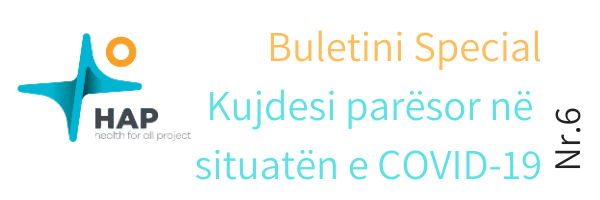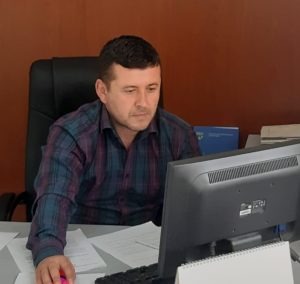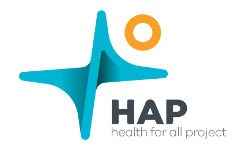
News
HAP assesses the needs for information and continuing education of primary care professionals by taking their most frequently asked questions and topics on which more information is needed. Based on this rapid needs assessment, HAP continuously processes COVID-19-related training materials. The main goal is to train primary care professionals in preventing the spread and control of COVID-19 infection as well as in informing and motivational counseling of individuals, families and community about their role. To download the materials published so far click HERE
Explanatory material for the general public has also been published so far at this LINK
- The COVID-19 infection map has is expanded in Dibra region where there is an infected, asymptomatic case in Bater e Vogel village. Since April 27, Dibra region has been declared a green area, which has led to the easing of measures on restriction of movement and consequently the increase of the number of visits to the health centers.
Bukurija is a retired nurse that has worked for several years at Peshkopi Health Center. She suffers from seven different conditions, which make her even more at risk for COVID-19, so she is isolated at home where she lives alone. Since the start of the pandemic, she has been receiving more care from her former colleagues, doctors and nurses at Peshkopi HC, who visit her regularly to monitor her health and deliver the medication she needs. She expresses her gratitude in this short video
Facing COVID-19: testimonies from professionals
Local Health Care Units across the country are also at the forefront of dealing with COVID-19 as they interact with primary health care teams in the respective region and the National Emergency Center to identify the infected or suspected COVID-19 cases and make the respective test.
We spoke with Mr. Erton Isufaj, Director of Mallakastra LHU, who told us more about the organization of work during the COVID-19 situation.
Mr. Isufaj, what support do you provide to primary health care teams in your area?
The cooperation of Mallakastra LHCU with the district Health Centers is close and mutual. It is the family physicians who in most cases are the first to encounter the suspected patients and those are the ones who monitor and continuously follow up the conditions of the patients. The Department of Epidemiology at the LHCU has conducted trainings for the HC staff in the framework of recognizing the protocols and algorithms for the prevention of the disease caused by SarS-CoV-2, and we coordinate the work for the management of various cases. All HCs have been supplied with the necessary protective materials for the health personnel and instructions and manuals for taking measures have been distributed as well. In this regard, I would like to thank Health for All Project for its contribution to the support of HC teams for taking and implementing measures to prevent and control the COVID-19 infection.
Specifically, how do you cooperate with the HC teams?
Pursuant to order no. 30 dated 16.03.2020 of the Central Operator’s Directorate “On the triage of patients”, the HC doctors, by phone, carry out the triage and identify those persons suspected with the coronavirus infection.
Afterwards, according to the “Case Definition and Surveillance of COVID-19”, family physicians refer the suspected cases to the LHCU where it is carried out the clinical/epidemiological assessment. The LHCU is the responsible authority that performs the nasopharyngeal sampling, if, according to the assessment of the family doctor, the criteria and clinical signs are met. If the case is at an aggravated stage and needs to be reported or hospitalized, the health center doctors, according to Law 15/2016, must notify and contact by phone the respective LHU, the infectious diseases doctor and the National Emergency Center/telephone 127.
What is the procedure followed by patients with COVID-19-like symptoms?
If the patients have symptoms similar to COVID-19 such as: dry cough, fever, difficulty breathing, physical weakness, increased sweating, sore throat, nausea/vomiting, diarrhea, loss of smell and taste, they may call their family doctor, the National Emergency number, 127, or the green number. They express their health complaints and concerns and for each case the medical teams perform the triage and assess whether it regards symptoms similar to COVID-19 or other respiratory diseases such as the common flu, pharyngitis, bronchitis, non-pneumonia coronavirus, asthma, COPD, seasonal allergies, etc.
If doctors assess that the patient needs to be tested, the team of epidemiologists at Mallakastra LHU is notified by phone and the case will be evaluated by performing a sample test, which currently consists of a nasal and nasopharyngeal tampon. The tampon is then transported to the virology laboratory at Tirana PHI, where the sample is analyzed.
In the event a patient presents a severe health condition, the medical team contacts the National Emergency 127 to enable safe transportation of the patient to the COVID-19 hospital for specialized treatment. If the patient contacts the family doctor, the National Center for Health Emergency 127, he/she is advised to not head straight to the health center or hospital. Depending on his condition, he/she is advised to stay at home for daily monitoring by his family doctor, and if his condition requires, he is advised to wait until measures are taken to transport him safely in order to prevent the spread of infection to others.
What are the biggest COVID-19 challenges you have faced with?
Among the challenges I would mention carrying out the differentiated diagnosis of COVID-19 with other respiratory diseases by phone consultations of family physicians. Thankfully, new data based on scientific studies are being published day by day, and all of our physicians are updated and assisted by us related to the new COVID-19 diagnostic criteria. Another challenge is to prevent the transmission of the infection to medical staff who face this risk every day. It is worth mentioning the physical distancing of health personnel from their family members is a psychological and emotional challenge for all health professionals who are at the forefront of coping with COVID-19.

